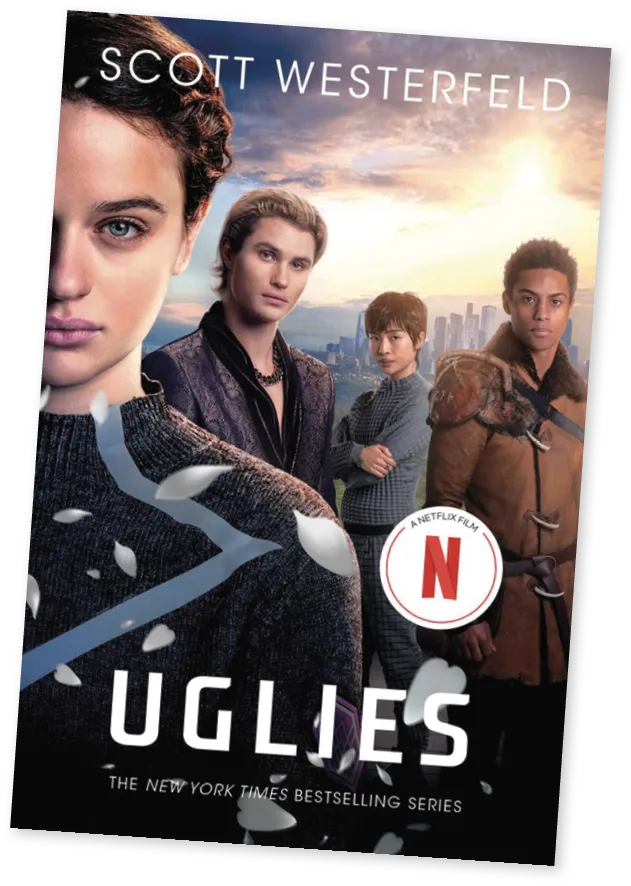Ressource affichée de l'autre côté.
Faites défiler pour voir la suite.
Faites défiler pour voir la suite.
Uglies is set in a dystopian future where society enforces
a strict standard of beauty. At age 16, all citizens
undergo a mandatory surgical transformation to become
“Pretties” — idealised, physically flawless versions of
themselves. Tally Youngblood is about to turn 16 and
looks forward to her surgery. However, she befriends a
girl named Shay who rebels against the procedure.


Book cover of Uglies.
Ressource affichée de l'autre côté.
Faites défiler pour voir la suite.
Faites défiler pour voir la suite.
Texte
Uglies
Tally turned her interface ring to bring up a menu on the wallscreen, and blinked her way through a set of eyemouse choices. The screen's camera flickered with laser light, and a green grid sprang up on Shay's face, a field of tiny squares imposed across the shape of her cheekbones, nose, lips, and forehead.
Seconds later, two faces appeared on the screen. Both of them were Shay, but there were obvious differences: One looked wild, slightly angry; the other had a slightly distant expression, like someone having a daydream.
“It's weird how that works, isn't it?” Tally said. “Like two different people.”
Shay nodded. “Creepy.”
Ugly faces were always asymmetrical; neither half looked exactly like the other. So the first thing the morpho software did was take each side of your face and double it, like holding a mirror right down the middle, creating two examples of perfect symmetry. Already, both of the symmetrical Shays looked better than the original.
“So, Shay, which do you think is your good side?”
“Why do I have to be symmetrical? I'd rather have a face with two different sides.” [...]
“I hate my right side. I always start with the left.”
“Yeah, well, I happen to like my right side. Looks tougher.”
“Okay. You're the boss.”
Tally blinked, and the right-side face filled the screen.
“First, the basics.” The software took over: The eyes gradually grew, reducing the size of the nose between them, Shay's cheekbones moved upward, and her lips became a tiny bit fuller (they were already almost pretty-sized). Every blemish disappeared, her skin turning flawlessly smooth. The skull moved subtly under the features, the angle of her forehead tilting back, her chin becoming more defined, her jaw stronger.
When it was done, Tally whistled. “Wow, that's pretty good already.”
“Great,” Shay groaned. “I totally look like every other new pretty in the world.”
“Well, sure, we just got started. How about some hair on you?” Tally blinked through menus quickly, picking a style at random. [...]
“Hey, Squint,” Shay said. “Whose face is this, anyway?”
“Just playing,” Tally said. “You want to take a shot?”
“No, I want to go hoverboarding.”
“Sure, great. But first let's get this right.”
“What do you mean 'get it right.' Tally? Maybe I think my face is already right!”
“Yeah, it's great.” Tally rolled her eyes. “For an ugly.”
Shay scowled. “What, can't you stand me? Do you need to get some picture into your head so you can imagine it instead of my face?”
“Shay! Come on. It's just for fun.”
“Making ourselves feel ugly is not fun.”
“We are ugly!”
“This whole game is just designed to make us hate ourselves.”
Tally groaned and flopped back onto her bed, glaring up at the ceiling. Shay could be so weird sometimes. She always had a chip on her shoulder about the operation, like someone was making her turn sixteen.
“Right, and things were so great back when everyone was ugly. Or did you miss that day in school?”
“Yeah, yeah, I know,” Shay recited. “Everyone judged everyone else based on their appearance. People who were taller got better jobs, and people even voted for some politicians just because they weren't quite as ugly as everybody else. Blah, blah, blah.”
“Yeah, and people killed one another over stuff like having different skin color.” Tally shook her head. No matter how many times they repeated it at school, she'd never really quite believed that one. “So what if people look more alike now? It's the only way to make people equal.”
Seconds later, two faces appeared on the screen. Both of them were Shay, but there were obvious differences: One looked wild, slightly angry; the other had a slightly distant expression, like someone having a daydream.
“It's weird how that works, isn't it?” Tally said. “Like two different people.”
Shay nodded. “Creepy.”
Ugly faces were always asymmetrical; neither half looked exactly like the other. So the first thing the morpho software did was take each side of your face and double it, like holding a mirror right down the middle, creating two examples of perfect symmetry. Already, both of the symmetrical Shays looked better than the original.
“So, Shay, which do you think is your good side?”
“Why do I have to be symmetrical? I'd rather have a face with two different sides.” [...]
“I hate my right side. I always start with the left.”
“Yeah, well, I happen to like my right side. Looks tougher.”
“Okay. You're the boss.”
Tally blinked, and the right-side face filled the screen.
“First, the basics.” The software took over: The eyes gradually grew, reducing the size of the nose between them, Shay's cheekbones moved upward, and her lips became a tiny bit fuller (they were already almost pretty-sized). Every blemish disappeared, her skin turning flawlessly smooth. The skull moved subtly under the features, the angle of her forehead tilting back, her chin becoming more defined, her jaw stronger.
When it was done, Tally whistled. “Wow, that's pretty good already.”
“Great,” Shay groaned. “I totally look like every other new pretty in the world.”
“Well, sure, we just got started. How about some hair on you?” Tally blinked through menus quickly, picking a style at random. [...]
“Hey, Squint,” Shay said. “Whose face is this, anyway?”
“Just playing,” Tally said. “You want to take a shot?”
“No, I want to go hoverboarding.”
“Sure, great. But first let's get this right.”
“What do you mean 'get it right.' Tally? Maybe I think my face is already right!”
“Yeah, it's great.” Tally rolled her eyes. “For an ugly.”
Shay scowled. “What, can't you stand me? Do you need to get some picture into your head so you can imagine it instead of my face?”
“Shay! Come on. It's just for fun.”
“Making ourselves feel ugly is not fun.”
“We are ugly!”
“This whole game is just designed to make us hate ourselves.”
Tally groaned and flopped back onto her bed, glaring up at the ceiling. Shay could be so weird sometimes. She always had a chip on her shoulder about the operation, like someone was making her turn sixteen.
“Right, and things were so great back when everyone was ugly. Or did you miss that day in school?”
“Yeah, yeah, I know,” Shay recited. “Everyone judged everyone else based on their appearance. People who were taller got better jobs, and people even voted for some politicians just because they weren't quite as ugly as everybody else. Blah, blah, blah.”
“Yeah, and people killed one another over stuff like having different skin color.” Tally shook her head. No matter how many times they repeated it at school, she'd never really quite believed that one. “So what if people look more alike now? It's the only way to make people equal.”
Ressource affichée de l'autre côté.
Faites défiler pour voir la suite.
Faites défiler pour voir la suite.
a) Tally is using the “morpho” technology on her friend Shay. What is the goal of a “morpho”?
Ressource affichée de l'autre côté.
Faites défiler pour voir la suite.
Faites défiler pour voir la suite.
b) How do the two images differ?
Ressource affichée de l'autre côté.
Faites défiler pour voir la suite.
Faites défiler pour voir la suite.
c) Pick out quotes showing Shay's reluctance to do a “morpho”.
Ressource affichée de l'autre côté.
Faites défiler pour voir la suite.
Faites défiler pour voir la suite.
d) What transformations does Tally make to the image?
Ressource affichée de l'autre côté.
Faites défiler pour voir la suite.
Faites défiler pour voir la suite.
e) How does Tally feel about the process?
Ressource affichée de l'autre côté.
Faites défiler pour voir la suite.
Faites défiler pour voir la suite.
f) What does Shay feel about the new image?
What is negative about everyone looking “pretty”?
Ressource affichée de l'autre côté.
Faites défiler pour voir la suite.
Faites défiler pour voir la suite.
g) What do the friends disagree about?
Ressource affichée de l'autre côté.
Faites défiler pour voir la suite.
Faites défiler pour voir la suite.
h) What does Shay think the real purpose of the game is?
Ressource affichée de l'autre côté.
Faites défiler pour voir la suite.
Faites défiler pour voir la suite.
i) What were they taught at school about how people in the past (our present) viewed beauty?
Ressource affichée de l'autre côté.
Faites défiler pour voir la suite.
Faites défiler pour voir la suite.
j) What is the link made by Tally and her school teachers
between physical appearance and equality?
Ressource affichée de l'autre côté.
Faites défiler pour voir la suite.
Faites défiler pour voir la suite.
Scott Westerfeld is an American author best known for his
young adult science fiction and dystopian novels. He was
born in 1963 in Texas. He now splits his time between the
U.S. and Australia. Westerfeld's early works include science
fiction and contemporary novels, but he gained widespread
recognition with his Uglies series, which explores themes of
beauty, identity, and societal pressure.


Ressource affichée de l'autre côté.
Faites défiler pour voir la suite.
Faites défiler pour voir la suite.
Design a beauty filter.
You are a software developer in the world of Uglies. You have created a new beauty filter that challenges the traditional standards of beauty and promotes individuality. Does your filter highlight unusual hairstyles, distinctive facial features, tattoos, scars? Once you've designed your filter, you must present and advocate your idea, explaining how it empowers people to express their true selves.
You are a software developer in the world of Uglies. You have created a new beauty filter that challenges the traditional standards of beauty and promotes individuality. Does your filter highlight unusual hairstyles, distinctive facial features, tattoos, scars? Once you've designed your filter, you must present and advocate your idea, explaining how it empowers people to express their true selves.
Cliquez pour accéder à un module d'enregistrement audio
Enregistreur audio
Une erreur sur la page ? Une idée à proposer ?
Nos manuels sont collaboratifs, n'hésitez pas à nous en faire part.
j'ai une idée !
Oups, une coquille
